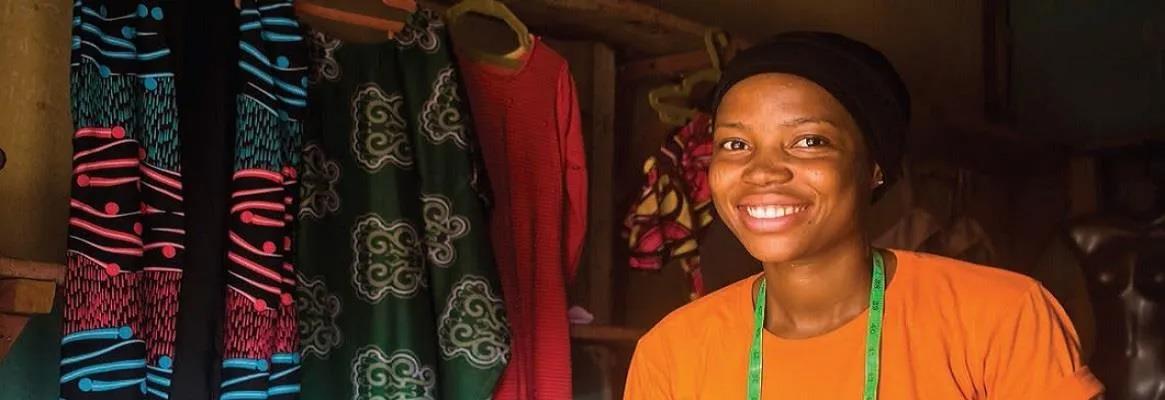Can Chinese investments save the Nigerian textiles and apparel industry? It is not all black and white, and many are caught in a bind.
A decent number of Nigerian celebrities have mentioned her brand on the red carpet. Many more have donned her designs on the big screen. “I’m living my dream,” says Kamsiie.
In just four years of her fashion design career, Kamsiie Ada Imoh, 27, has worked for some of the biggest movie/TV production companies in Africa including RaveFilms, Topshot Media, with production showing on AfricaMagic, IrokoTV, RaveTelevision, Nollywood plus, among others. She has expanded her business from pr�t-a-porter to haute couture and costume designs.
Ada Imoh’s unique designs have caught the attention of producers in the world’s third largest movie industry, Nollywood. She feels fulfilled but wants to see the Nigerian fashion industry grow the way its movie industry has continued to grow in the face of challenges.
“There’s a lot of talent in the Nigerian fashion industry, but capital is a huge challenge. I had to work for a few years before realising my dream of becoming a fashion designer,” says Ada Imoh. “There is also the challenge of production cost. My brand Kamsiie Couture is known for its quality of design and finishing, but to achieve the kind of finishing we’ve come to be known for, we’ve had to invest so much in equipment and procurement of fabric, mostly from abroad.” Then, she goes on to conclude: “A stronger local textiles industry will do us a lot of good.”
The Death of the Past
The heydays of the Nigerian textiles industry ended decades before Ada Imoh was even born. At its peak, the industry employed close to 700,000, second only to the government and operated about 180 mills. According to the Oxford Business Group, Nigeria currently has 25 textile mills, running at a sector average of 40 per cent capacity and employing around 25,000 people in total. Industry stakeholders attribute the troubles of the industry to a lack of funds to upgrade their machines to newer efficient models that will improve profitability. Experts have also identified insufficient cotton seeds for production, high cost of operations, smuggling, counterfeiting, a high influx of cheap textiles and apparel, poor infrastructure especially power, and poor production standards.
To save the industry, the Nigerian government has tried different policy options from banning and unbanning of imports to the introduction of intervention funds, mandatory government purchases, and much recently banning of forex access for textile importation. According to the governor of Nigeria’s central bank, Godwin Emefiele, the country spends more than $4 billion annually on imported textiles and ready-made clothing. He put the potential market size of the domestic textiles industry at over $10 billion and believes the latest policy move will help the industry grow.
But restricting access to forex for textile importers is not going to automatically make the industry grow. Major challenges facing the whole value chain start from cotton production, where farmers decry the availability of high-quality seeds. To address this, the Institute for Agricultural Research (IAR) has introduced 13 varieties so far, which are a long staple and often resistant to pests. However, in a country where 80 per cent of the cotton producers are small to medium-scale farmers, the growth potential is not being fully realised and a lot of funding needs to go into the industry. The right amount of investment can help to improve cotton production and revive moribund textile companies, creating more demand for the cotton produced. It will also help the apparel industry to be more competitive.
The Chinese Expansion
The Nigerian textiles and apparel industry has attracted foreign investment since its early days. By the 1980s, Indians had become the single largest group of private owners of textile plants, and the Chinese Cha group was the largest private owner. The Chinese company had established the United Nigerian Textiles Ltd (UNTL) in Kaduna in 1964 as its first overseas operation and expanded to other parts of the country, including Lagos, Nigeria’s commercial capital.

Chinese investment in the Nigerian textiles and apparel industry has continued with the Shandong Ruyi Group, China’s largest textiles manufacturer, planning a $2 billion investment in the whole value chain of the Nigerian industry. It is also building a $600 million textiles industrial park in Kano, a city in northern Nigeria, 235 km from Kaduna. However, there are mixed reactions to the company’s investment in Kano, with many blaming China for decades of job losses in the industry.
In Kano, the centuries-old dye pits used to employ about 2,000 people more than a decade ago; this has dropped to about 250 as the pits struggled to compete with a cheaper imitation from China. Chinese companies produce identical patterns of fabrics using synthetic dyes, and these find their way to the markets in Kano and other parts of Nigeria, often through illegal means. According to World Bank estimates, textiles smuggled through countries such as the Republic of Benin are worth $2.2 billion a year.
Tom Burgis, in his book, The Looting Machine, wondered how the Nigerian textiles industry did not totally collapse “given the power crisis, the near-impassable state of Nigeria’s roads, and the deluge of counterfeit clothes.” He continued: “The knock-on effects of this collapse are hard to quantify but they ripple far into the Nigerian economy, especially in the north.”
Aminu Abubakar, 43, had to move to Abuja to start driving a cab after his income dwindled as the pits struggled, with identical patterns from China flooding the market. “I don’t believe China has anything good to offer,” says Abubakar. “I blame China for the jobs lost in our industry. But if the government believes they will create jobs, it’s okay.”

The Rock and the Hard Place
Burgis agrees with Abubakar. In his book, he quoted a consultant who spent years researching the “slow death” of Nigerian textiles to have said that the Chinese attacked the wax-print and African-print segment, which were the heart of the industry. The consultant told Burgis that there were 16 factories in China dedicated to making textiles with “Made in Nigeria” badges. These were smuggled into the country, sadly, by locals, whose textiles industry was at the receiving end of the illicit acts. Gradually, the Chinese, with their often cheaper textile, started to take control of the market.
“I know some of our brothers were complicit,” says Abubakar, as he nods in agreement. “But that does not mean we should forget what China did. I wouldn’t take a kobo of their money,” he fumes. But his government will take it if it means the textiles industry in Kano will come back to life.
Abubakar says it was painful leaving his family behind in Kano, but even if Chinese investments revive the textile industry back home, he’s not going back.
Unlike Abubakar, working in the textiles industry took Adeola Araromi, 34, back home. She had worked four years at a top commercial bank in Abuja, saving up to start her textiles trading and design business in the ancient Nigerian city, Ibadan where she grew up. When she thought she had enough capital to start, she resigned.
“I was a bit naive. I thought I would get everything I needed locally and so I planned in Naira. But once I factored in the exchange rate, it dawned on me that I did not really have enough. I started anyway, but with support from family and friends.”
Araromi, who runs Fabricz by Mercy, says she’d rather not import anything. “I would rather buy locally because I want to support my country and help in creating more jobs for the unemployed population. Also, I believe the designs produced locally are unique to who we are as Africans and speak more to our culture than what an external person can come up with. It’s just bad that they imitate original African designs, produce them in China, smuggle them in, and sell for cheap.” She adds, “We need to tackle smuggling, develop our infrastructure and introduce policies that support businesses so that our industry can be more competitive.”
She agrees that the Nigerian textiles and apparel industry needs a lot of investment, which is currently scarce. As much as she’s not a fan of Chinese investment, she concludes “beggars can’t be choosers. And if Chinese investment is the answer, count me in.”
This article was first published in the October 2020 edition of the print magazine.











Comments